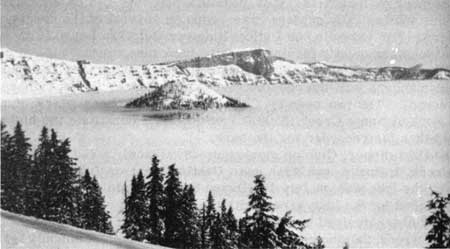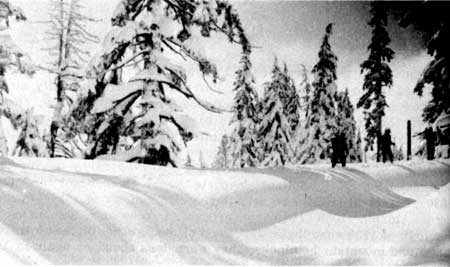Continued from Volume 17 page 1
Ornithological Notes of Interest
The summer of 1951 was somewhat unusual because of the very early disappearance of the snow and further because of the relatively high temperatures and the almost total lack of precipitation during July and August. Although it is not possible to designate these factors as causal, it is nevertheless of interest to note, in correlation, certain interesting changes which occurred with respect to the avifauna of the park.
The summer was characterized by an unusual number of turkey vultures, Cathartes aura (Linnaeus). During the course of the summer ten individual observations were recorded; this is equal to the total records accumulated for all previous years. Two of the records are from high on the slopes of Garfield and Applegate Peaks respectively. The previous high-elevation records were from park headquarters (Sparrow, 1921) and Munson Meadows (Aldrich, 1937). Red-tailed hawks, Buteo jamaicensis (Gmelin), on the other hand, were considerably less abundant. For July and August, I recorded only five; during 1950 I saw eleven during the same period, and during August, 1949, I saw 20. On July 7 and 8, at Llao Rock and the Rim Village respectively, I saw single ferruginous rough-legged hawks, Buteo regalis (Gray). To the best of my knowledge, these are the first July records for the park. As usual, the first sparrow hawks, Falco sparverius(Linnaeus), appeared in the rim area during the first week of August. My first record was from Llao Rock on August 3; they were observed commonly thereafter.
The upward migration of the blue grouse, Dendragapus obscurus (Ridgway) appeared to be somewhat earlier than normal. On July 28 I flushed two at 7700 feet on Dutton Ridge and on August 2, C. F. Yocom saw a female and seven chicks at the headwaters of the East Fork of Annie Creek at about 6500 feet. On August 11, I saw a flock of seven at the summit of Timber Crater. Thereafter there were numerous reports of this species from higher elevations.
On July 4 I found a nest and four eggs belonging to a pair of spotted sandpipers, Actitis macularia (Linnaeus), in upper Munson Meadow. The nest was unsuccessful. There are previous records of breeding spotted sandpipers in this area for the summers of 1940 and 1944. As usual the species was fairly abundant on the lakeshore. California gulls,Larus californicus Lawrence, were somewhat more numerous on the lake than usual; on August 22 I saw 58 on the launch trip. Most of them were resting along Skell Channel.
In general the summer was apparently a poor one for woodpecker I saw no pileated woodpeckers, Ceophloeus pileatus (Linnaeus); Williamson sapsuckers, Sphyrapicus thyroideus (Cassin); Arctic three-toed woodpeckers, Picoides arcticus (Swainson); or American three-toed woodpeckers, Picoides tridactylus (Linnaeus). Flickers, Colaptes cafer (Gmelin); and hairy woodpeckers, Dryobates villosus (Linnaeus), were substantially less abundant than usual. Of particular interest was the white-headed woodpecker, Dryobates albolarvatus (Cassin), which I saw on Sand Ridge on August 5. There are only six previous records for the Park.
Another lower-elevation species which appeared in the higher parts of the park this summer was the Western wood peewee. They were seen repeatedly in the Shasta fir forest at the headwaters of the East Fork of Annie Creek; that breeding occurred there is indicated by the two juveniles which I saw begging from an adult on August 7. There were records from park headquarters and the lakeshore below Cloudcap. Normally this species breeds only in the lowest parts of the park such as along lower Annie Creek. Previously, however, it was found at higher elevations in 1926 and 1927 (Munson Meadow, by A. H. and Loye Miller), and in 1940 (several localities, Fletcher Palmer).
During the first week in August definite evidence of the breeding of Wright’s Flycatcher,Empidonax wrightii Baird, was obtained. An adult, positively identified as a specimen, was observed on the north slope of Sand Ridge feeding three young very recently from the nest.
Although the number of nutcrackers, Nucifraga columbiana (Wilson), at the Rim Village in early July approached normal levels, the characteristic increase in population which ordinarily occurs during July and August failed to materialize. Actually, they became less common after the first of August. I am inclined to regard this not necessarily as a decrease in the population of this species but rather as an indication of a more general dispersal throughout the park. In support of this my notes show considerably greater numbers than in other years at a number of localities. It is possible that this can be correlated with the substantially greater cone crops on several of the species of conifers. For example, on Dutton Ridge on July 22, I saw 18 in two hours; all were quietly feeding on white-bark pine cones.
Also among the lower-elevation species which appeared in considerable numbers was the chestnut-backed chickadee, Parus rufescens (Townsend). The two seen by C. F. Yocom at the headwaters of the East Fork of Annie Creek (6500 ft.) on August 2 constitute the highest record thus far recorded for the park.
The first dipper, Cinclus mexicanus (Swainson), noted in the Munson Creek drainage was seen near Castle Crest on July 8; the first seen on the lake was on July 10 (Duane S. Fitzgerald). The unusually early record for the lake agrees with the July 11 record for 1940 which was also characterized by early loss of snow.
Rock wrens, Salpinctes obsoletus (Say), were again commonly heard on the Garfield Peak Trail. I saw an adult carrying food repeatedly early in August but was unable to find the nest.
During the first two weeks in July, varied thrushes, Ixoreus naevius (Gmelin), could be heard in the vicinity of park headquarters and elsewhere in the mountain hemlock forests. I am convinced that there were substantially greater numbers this summer than there have been during any summer which I have spent in the park.
Although they were abundant in the lodgepole forests east of the park, there was a remarkably small number of ruby-crowned kinglets, Regulus calendula (Linnaeus), within the park. Very few could be found in the Kerr and Pinnacles valleys where they are ordinarily quite abundant.
On August 7, a juvenile specimen of a black-headed grosbeak, Pheucticus melanocephalus (Swainson), was obtained along lower Sun Creek. This is the third authentic record for the park.
Lazuli buntings, Passerina amoena (Say), were again relatively abundant. Each of the little meadows along lower Annie Creek canyon contained at least one lazuli bunting territory. However, there was also a marked upward expansion. Records were obtained of territorial males in Wheeler Creek Canyon, headwaters of the East Fork of Annie Creek, upper Castle Creek, and park headquarters. Previous summers in which this species was common at higher elevations were those of 1926 (A. H. Miller and Loye Miller) and 1940 (Fletcher Palmer and D. S. Farner). Pine siskins, Spinus pinus Wilson, were present in the last two years. During the summer of 1951, I saw siskins at the rate of about 9.0 per hour in the field; the rates for 1950 and 1949 were 2.2 and 2.6 respectively. Possibly this great abundance is to be associated with the substantially more abundant cone crops. More definitely to be associated with the abundant cone-crop is the irruption of red crossbill’s, Loxia curvirostra Linnaeus.

The Sapphire Lake becomes a cauldron of fog
The Red Crossbill Irruption of 1951
Unquestionably the most spectacular ornithological phenomenon of the summer of 1951 was the prodigious numbers of red crossbills, Loxia curvirostra Linnaeus.
These spectacular nomadic finches were reported continuously and in substantial numbers from all parts of the park. They were the repeated subject of questions and comments by large numbers of visitors most of whom have only the most casual interests in birds. At the Rim Village they could be observed repeatedly at distances of a very few feet as they pecked systematically, possibly for minerals, at the andesite blocks of the retaining wall. The same behavior was observed less frequently at fireplaces and at broken places on the pavement of the highways.
Crossbills were relatively abundant during the summer of 1950, but the numbers observed then were greatly eclipsed by the numbers recorded this season. My field notes yield a reasonably useful comparison in terms of the numbers of crossbills seen per hour in the field during several summers in the park.
| Year
|
Hours in the field
|
Number of Crossbills Seen per Hour |
| 1940 | 50 | 0.1 |
| 1941 | 50 | 0.1 |
| 1942-1945 | no records | |
| 1946 | 65 | 0.9 |
| 1947 | no records | |
| 1948 | 74 | 0.5 |
| 1949 | 42 | 1.0 |
| 1950 | 111 | 1.7 |
| 1951 | 110 | 5.5 |
Although no nests were found I am quite certain that breeding has occurred in the park during 1951. Pairs were seen repeatedly, singing was common, courtship display was observed several times, copulation was observed once, a juvenile bird was observed being fed, and the specimens obtained for the park collection were in breeding condition.
With respect to periods of abundance in the past it is interesting to note that Miller and Miller (ms. 1926) observed only a few in 1926. Superintendent E. C. Solinsky reported them as abundant in October 1930. Campbell (1934) saw none during the summer of 1934. According to Aldrich (1938, 1940) red crossbills were abundant during the summer of 1938 when there were good crops of cones on the white-bark pines and mountain hemlocks; they were less abundant again in 1939 and quite uncommon during 1940. During 1938 Aldrich (1940) observed a juvenile being fed by an adult.
The “mineral pecking” behavior which was observed so frequently this summer was also observed repeatedly during the summer of 1938 (Aldrich, 1939) and less commonly during 1939 and 1940.
The specimens obtained during 1950 and 1951 indicate that the race involved in this irruption is bendirei Ridgway.
References Cited
Aldrich, Elmer C.
1938. Notes on the Sierra Crossbill. Crater Lake National Nature Notes,11(3): 27-29
1939. Notes on the salt-feeding habits of the Red Crossbill. Condor, 41(4): 172-173.
1940. Notes on the birds of Crater Lake National Park, Oregon. Condor, 42(2): 89-90.
Campbell, Berry
1934. Annotated list of the vertebrates of Crater Lake National Park. Mimeographed, National Park Service, Crater National Park, 22pp.
Miller, Loye, and Alden H. Miller
1926. Birds observed in Crater Lake National Park during the season July 1 – August 15, 1926. Manuscript in the files of the Museum of Vertebrate Zoology, University of California, Berkeley.


